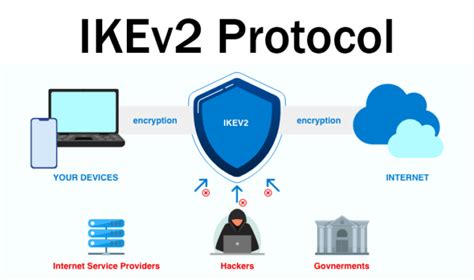5 IKEv2 Tips

The realm of internet security is vast and complex, with numerous protocols designed to protect our online activities from unwanted access. One such protocol that has gained significant attention in recent years is IKEv2 (Internet Key Exchange version 2), a key component in setting up and managing IPsec (Internet Protocol Security) connections. IKEv2 is particularly noted for its ability to securely and efficiently establish, as well as manage, IPsec VPN (Virtual Private Network) tunnels. For those looking to delve into the world of IKEv2 or enhance their existing setup, here are five valuable tips to consider:
1. Understanding IKEv2 Basics
Before diving into the intricacies of IKEv2, it’s essential to grasp its fundamental principles. IKEv2 operates in two phases: the first phase authenticates the peers and sets up an encrypted channel (IKE SA), and the second phase negotiates the IPSec SAs to encrypt the actual data. Understanding these phases can help in troubleshooting and optimizing IKEv2 connections. For instance, knowing that the first phase involves the Diffie-Hellman key exchange can help in choosing appropriate parameters (like the key size) to balance between security and performance.
2. Choosing the Right Authentication Method
IKEv2 supports various authentication methods, including pre-shared keys (PSK), digital certificates, and Extensible Authentication Protocol (EAP). The choice of authentication method significantly affects the security and usability of the VPN. For example, while PSKs are simpler to set up, they offer lower security compared to digital certificates, which can provide better authentication but require a more complex infrastructure. Enterprises might prefer certificates for their added security, whereas individuals might find PSKs more convenient. It’s crucial to weigh these factors when selecting an authentication method for IKEv2 VPNs.
3. Configuring for Mobility
One of the standout features of IKEv2 is its support for MOBIKE (Mobility and Multihoming), which allows VPN users to move between different networks (e.g., from Wi-Fi to cellular) without losing their VPN connection. Configuring IKEv2 to support MOBIKE involves setting up the VPN client and server to handle address changes and to initiate the necessary updates to keep the connection alive. This feature is particularly beneficial for individuals who need consistent, secure access to their network resources while on the move.
4. Enhancing Security with Advanced Settings
While IKEv2 provides strong security out of the box, there are several advanced settings that can further enhance its security posture. This includes the selection of cryptographic algorithms, the use of Perfect Forward Secrecy (PFS), and implementing robust key management practices. For instance, choosing algorithms like AES-256 for encryption and SHA-256 for integrity checks can offer higher security levels. Additionally, enabling PFS means that even if an attacker obtains the long-term key, they will not be able to decrypt previously captured traffic, adding an extra layer of protection against future attacks.
5. Troubleshooting IKEv2 Connections
Troubleshooting IKEv2 connections can be complex due to the protocol’s intricacies and the variety of devices and software that implement it. When issues arise, starting with the basics—such as ensuring that both ends of the connection are correctly configured and that there are no firewall rules blocking necessary ports (typically UDP 500 and 4500)—can quickly resolve many problems. Utilizing logging and debugging tools available on both the client and server sides can also provide valuable insights into where the connection process is failing, helping to identify and fix issues more efficiently.
Conclusion
IKEv2 offers a powerful and flexible solution for establishing secure VPN connections. By understanding its basics, choosing the right authentication method, configuring for mobility, enhancing security with advanced settings, and having a systematic approach to troubleshooting, users can maximize the benefits of IKEv2 and ensure their online activities remain protected. As the digital landscape evolves, protocols like IKEv2 will continue to play a critical role in safeguarding our communications, making it essential to stay informed and adapt configurations as new security threats and mitigation strategies emerge.
What are the primary advantages of using IKEv2 for VPN connections?
+IKEv2 offers several key advantages, including strong security through the use of encryption, flexibility in authentication methods, and support for mobility through MOBIKE. This makes it an attractive choice for both personal and enterprise VPN solutions.
How does MOBIKE in IKEv2 enhance VPN connectivity for mobile users?
+MOBIKE allows IKEv2 to maintain VPN connections even when the user’s device changes its IP address, such as moving from a Wi-Fi network to a cellular network. This ensures that the VPN connection remains active and secure, providing uninterrupted access to protected resources.
What role does Perfect Forward Secrecy (PFS) play in enhancing IKEv2 security?
+PFS ensures that each session uses a unique set of keys, generated through ephemeral Diffie-Hellman key exchange. This means that even if an attacker obtains the long-term key, they will not be able to decrypt the data from past sessions, significantly enhancing the security of the connection against future compromises.


